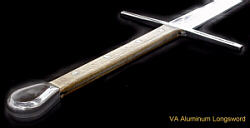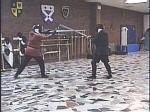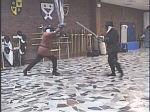
The "perfect" training weapon?
by Brian McIlmoyleAugust 29, 2002
Assessment and Review of Valentine Armouries's Aluminum Longsword
 AEMMA as a result of our ongoing research and development has been searching for an effective "long sword foil", an instrument of training that we can fence with wearing light equipment. The desire being to simulate unarmoured long sword combat.
AEMMA as a result of our ongoing research and development has been searching for an effective "long sword foil", an instrument of training that we can fence with wearing light equipment. The desire being to simulate unarmoured long sword combat.
Many of our colleagues use wooden wasters for this purpose but we have found that the handling characteristics and the rigidity of wooden swords make them a poor sword simulator. Wooden swords do not bend and so thrusts must be done very carefully to avoid injury. In addition due to their rigidity and lack of harmonic characteristics wooden swords don't bind effectivly and tend to bounce rather than bind. This has a significant effect on the character of the fight and the effectiveness of proper technique. This coupled with the forward balance point of wasters makes for an instrument that is both dangerous and ineffective to be used for free assault. The majority of injuries suffered by Schollers and recruits has been as a direct result of the specific nature of wooden wasters. I still support the use of wooden wasters for initial handling skills development and solo practice, but truthfully a replica steel sword would be better for this. Wooden swords due to their relative low cost and ease of acquisition will undoubtedly continue to form a part of the equipment used by AEMMA. Other practitioners employ padded sword simulators which have known limitations as a "sparring tool" and as they have never been employed by AEMMA I won't address them.
Although AEMMA members are known as practitioners of armoured combat, this practice forms only a small part of our research and practice. Primarily we are engaged in the study of the individual self defense skills of the middle ages. This involves primarily the study and practice of unarmoured fighting skills both with weapons and unarmed. Consequently we have been looking for an effective simulator for the steel long sword for use in our free fencing with this weapon. A blunt steel sword is an imperfect solution as even blunt, the edge profile is still keen enough to cause significant damage in an impact with a finger or arm. Our forefathers solved this problem by employing "foils" or training swords composed of a narrow flat bar with a wide edge profile, there are a few surviving examples of this type of training weapon in museums throughout the western world. Some modern sword makers have replicated these training swords and by all accounts they are an effective if somewhat expensive solution. As a result our search continued for a training sword that combined the proper weight and handling of a long sword with an accurate blade profile. The item must be able to be used with light protection (1) and have the flexibility and binding characteristics of a replica sword with a edge profile wide enough to minimize the potential for injury. Finally the cost of the item must be such that it is within the bounds of investment for a beginning practitioner, we calculate this as the cost of 2 wasters.
Our search ended with the discovery of the Aluminum Practice Swords manufactured and marketed by Valentine Armories located in Calgary Canada. Valentine Armories graciously offered to us a pair of these weapons to test,  we had just broken our 15th waster this year so we were primed for finding an alternative. Upon receipt of the swords I was struck by the simplicity and grace of their design and the professional execution of their manufacture, they looked really nice. Next I took one to hand, although they outweighed a typical waster by about 1\2 a pound ( about 3 lbs ) it felt much lighter by virtue of its superlative balance. Most of the weight of the weapon was resident in the lead hand, the balance point was 1 inch up from the cross.
we had just broken our 15th waster this year so we were primed for finding an alternative. Upon receipt of the swords I was struck by the simplicity and grace of their design and the professional execution of their manufacture, they looked really nice. Next I took one to hand, although they outweighed a typical waster by about 1\2 a pound ( about 3 lbs ) it felt much lighter by virtue of its superlative balance. Most of the weight of the weapon was resident in the lead hand, the balance point was 1 inch up from the cross.  Many may say this is too low and I would agree for a sword designed for heavy cutting but for a sword designed to be used unarmoured this balance point is exactly what I would want. Point control and quickness more than makes up for the ability to cut from shoulder to hip. I have had the opportunity to handle a number of swords in the reserve collection at The Royal Ontario Museum here in Toronto and many of the swords balanced very close to the cross so I am confident that this condition does not produce inaccuracies in the fight. Now I approached Scholler Murphy(2) and Scholler Armstrong(2) and admonished them to "test them out". Both of these fellows are voracious fighters who love free play. They started out working some of the basic countering plays from Liberi and so I left them to their own devices as I had a batch of new recruits to dominate my attention. By the end of practice they had on their arming coats and fencing masks and where happily taking up the entire salle in their free assault upon each other. Swords clashed cuts and thrusts landed and what struck the most was how fast and hard they were going, faster and harder than ever dared with wasters. After, I asked them what they thought about the new swords. The unqualified response was "THESE ARE GREAT!!!" The consensus was that they feel and handle like a sword should allowing all the subtleties of technique that wasters don"t and they strike with non injurious force with both cuts and thrusts. In all, the best fighting experience they had ever had (out of armour) ever. It was felt that the Valentine Aluminum Practice swords allowed very safe full speed assault with limited danger of injury. No limitation of technique or target area was required to ensure safety. By virtue if their balance, weight and blade dimension (3\8 inch thick) the wielder, if properly trained, can freely strike and thrust with infinite control and finesse with confidence that the equipment worn will protect his companion from injury.
Many may say this is too low and I would agree for a sword designed for heavy cutting but for a sword designed to be used unarmoured this balance point is exactly what I would want. Point control and quickness more than makes up for the ability to cut from shoulder to hip. I have had the opportunity to handle a number of swords in the reserve collection at The Royal Ontario Museum here in Toronto and many of the swords balanced very close to the cross so I am confident that this condition does not produce inaccuracies in the fight. Now I approached Scholler Murphy(2) and Scholler Armstrong(2) and admonished them to "test them out". Both of these fellows are voracious fighters who love free play. They started out working some of the basic countering plays from Liberi and so I left them to their own devices as I had a batch of new recruits to dominate my attention. By the end of practice they had on their arming coats and fencing masks and where happily taking up the entire salle in their free assault upon each other. Swords clashed cuts and thrusts landed and what struck the most was how fast and hard they were going, faster and harder than ever dared with wasters. After, I asked them what they thought about the new swords. The unqualified response was "THESE ARE GREAT!!!" The consensus was that they feel and handle like a sword should allowing all the subtleties of technique that wasters don"t and they strike with non injurious force with both cuts and thrusts. In all, the best fighting experience they had ever had (out of armour) ever. It was felt that the Valentine Aluminum Practice swords allowed very safe full speed assault with limited danger of injury. No limitation of technique or target area was required to ensure safety. By virtue if their balance, weight and blade dimension (3\8 inch thick) the wielder, if properly trained, can freely strike and thrust with infinite control and finesse with confidence that the equipment worn will protect his companion from injury.
I took the swords home that night to inspect them. Apart from expected burrs on the square edge of the blades and some scratches on the surface they were undamaged. I took a file and quickly dressed the edges removing the burrs (they should have been filed round before use). The next night a good friend and AEMMA Scholler Kel Rekuta(2) and I went at each other with the new swords. Kel and I have been fighting each other for going on 15 years now so we know and trust one another and fight quite free regardless of the implement used. With these Valentine Aluminum Practice Swords we had an absolutely incredible fight experience. We cut, slashed and thrust each other with gleeful abandon finally quitting in exhaustion after over an hour of full speed free assault (with a couple of breaks). We both agreed that the weapons performed exceptionally well and surpassed all our expectations with respect to safety and effectiveness as a free fighting sword simulator. The swords bind well without bouncing, they flex and slide just as a steel sword does and the degree of control available to the user is not limited by the sword. In strikes, and I received my fair share, they land with telling force but without injury even in incidental and direct hand hits. Thrusts, due to the flexible blade land with authority but once again without injury. In short I am very impressed with the Valentine Aluminum Practice Sword and we intend to adopt these weapons as our principal training weapon for free assault. After substantial and unrestricted use the blades suffered only cosmetic damage. Valentine guarantees these weapons against breakage for five years!! And I believe that they will serve for much longer.
I can and do without hesitation provide my highest endorsement and support for the Valentine Aluminum Practice Sword as an effective and safe free fighting training sword. Armed with these weapons and with effective protection I feel that our ability to train at realistic speed and with effective force is greatly increased. I also believe that the degree of safety in free assaults is substantially enhanced by the employment of these weapons. AEMMA will be buying allot more of these weapons and we will recommend to our recruits to purchase a Valentine Aluminum Practice Sword over a wooden waster. We will also recommend to our Chapters, Associated groups and Affiliates to adopt and recommend the use of these weapons in their study and practice.
Click on each image below to view video segments of the evaluation, i.e. fencing bouts using their aluminum swords. The last image is a video of the final assessment of the swords. The fencing bout videos range in size from 440KB to 692KB, the review video file size is 11MB (it is recommended you use high-speed access for this file).
Notes:
- Light protection is, reinforced padded gloves such as lacrosse gloves or street hockey gloves with hardened leather "finger bucklers", a moderately padded arming coat, a solid gorget with cervical protection, rigid cops on the elbows and knees and a 3 weapon Fencing mask.
- All persons employing the weapons in this test were AEMMA Schollers or Free Schollers with a minimum of 18 months of historical Swordsmanship training.
- The weapons supplied by Valentine Armouries are available at a retail cost of $150.00 USD from Valentine Armouries.
- The endorsement provided by AEMMA is done with no compensation by Valentine Armouries other than the weapons supplied.
- The Valentine Aluminum specs: 3/16" thick, 7075 series T6 tempered aircraft aluminum - flat.
About the author: is the Vice President and co-Founder of AEMMA and who has been studying and practicing Medieval swordsmanship in various forms for 16 years. He is also AEMMA's Principle Instructor and has been deeply involved in the development of the AEMMA training program. His 10 years of Canadian Armed forces experience is leveraged in the disciplined training of students. Current projects include the formalisation of armour, weapon and judging standards for use within Medieval swordsmanship tournaments. Brian's goal is to assist in the creation of a viable Western Martial Arts tradition that can co-exist on equal terms with the existing Eastern Martial Arts tradition. Brian had received his designation of free scholler in Oct, 2000. Brian also received his appointment of "Acknowledged Instructor" (AI) designation for armoured longsword instruction in October 14, 2001 by the International Masters at Arms Federation (IMAF).



